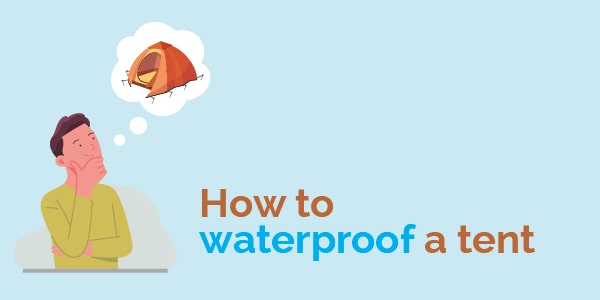Let’s be honest, we can try and pick the best weekend to go away camping, checking the sun forecast, whether there’s clear skies and more…but, as any experienced camper knows, all best-laid plans have a risk of something going wrong, and no matter what the forecast, plan for a sunny camping trip and it’s bound to rain.
Note: Slight exaggerations here – it’s not always the case. Sometimes you go away and you get a glorious weekend! However, it’s always good to plan for the worst so that means making sure that if it does rain your tent isn’t going to leak.
The majority of tents are covered into a waterproof membrane or treated to stop moisture from soaking through.
However, after a while, this is going to wear away and it will need to be replaced using a waterproof spray.
With this in mind, let’s have a look at the simple steps you need to do to re-waterproof your tent so that you can use it in any weather.
Steps to Re-waterproof your tent:
- Pick a warm dry day
- Clean your tent – removing any mud and grass
- Seal all the seams – this can help keep moisture from seeping through
- Refresh the urethane coating (this is the coating on the inside of your rainfly and floor)
- Refresh the DWR (Durable Water Repellent) coating. This is on the outside of your tent and helps the remove the water quickly of the surface of your tent

How to re-seal the seams
The seams are the most vulnerable part of any tent as this is where two different pieces of fabric have been stitched together. Like the rest of the tent, seams have a waterproof layer to stop moisture seeping in and it’s essential to protect them as well as the rest of the tent.
- Choose a dry day outdoors or somewhere indoors. A garage or conservatory is a good place if you can’t put your tent up outside. You will need to leave the proofing to dry.
- Put up your tent, but as the seams are on the inside, don’t put any bedrooms or other internal sections in.
- Clean the seams. Use rubbing alcohol and a soft cloth to clean the seam. Carefully remove any bits that are peeling off.
- Following the instructions on the bottle, apply the seam sealer. Make sure you get the right seam sealer for your specific tent. There are two main types; polyurethane-coated and silicone-treated, and both require different sealer.
- Now leave to dry.
Expert Tip: Even if it’s just seems to be a small part of the seam letting in water, I would recommend you reproof as much as you as can. It is likely other areas will be weak and need reproofing shortly so give the whole thing a good going over. If the seams are coming apart or damaged, then you will need to get them repaired.
Where to Buy Seam Sealer
How to re-apply the urethane coating
The urethane coating, over time, will start to flake. So, as soon as you notice any flakes anywhere on the tent, either on the rainfly or the floor of the tent you need to apply a new coating. I know it’s tempting to leave it a bit, but the earlier you act, the better protected your tent will be.
- Lay out the material on a dry, flat surface
- Find all the flaking sections and carefully scrub them off
- Then, apply a thin coating of tent sealant as per the bottle instructions. There are different types, as mentioned above, so please make sure you purchase the correct type.
Leave to dry for a minimum of 24 hours.
Where to Buy urethane coating
How to re-apply the DWR coating
The DWR (durable water repellent) coating prevents water soaking through your flysheet. It makes the water bead up and run off. I find doing this when the tent is up much easier.
- Clean the outside of your tent’s flysheet. Use water if needed. You don’t need to wait for it to dry
- Apply the tent waterproofing spray evenly over the fly – you might need some steps or ladders to get to the top of your tent.
- Wipe off any excess coating with a damp soft cloth
- Leave to dry
Expert tip – If you plan on using your tent during bad weather, I would recommend adding an extra coating. Note: the tent needs to be dry before applying the second coat.
Where to Buy DWR Coating
Waterproofing a polycotton tent
A polycotton tent or canvas tent is different from a regular tent when it comes to waterproofing.
They do have a water-repellent coating, but they will need weathering before you use them.
Simple Steps
- Put your tent up
- Using a hose, lightly wet the tent
I know this sounds counterproductive. But it works. This is because when the tents are stitched together small holes are left which can let water in. By wetting the tent, the weave tightens up and expands the materials, making it even more waterproof.
How often should you reproof your tent?
First of all, a waterproof coating should last a while, so if you have just bought a new tent then you don’t need to worry about waterproofing for a while.
There are some simple things to look out for to notice when your tent needs re-waterproofing. But, put simply, the more you use your tent the sooner you will need to re-waterproof it. Signs to consider re-proofing include:
- If you notice some flaking
- If you are camping and notice when it’s raining that water is entering your tent.
- Or, if it’s raining and your tent is up, and you notice your tent isn’t beading water as well as it used to.
If any of these ring true, it’s time to re-waterproof your tent.
Check before you go
This can also be checked at home, simply put up your tent and spray lightly with a hose and watch how the water runs off.
You can never predict when it’s going to rain, so it’s always best to make sure your tent will keep you dry. There is nothing worse than having a leaky tent mid trip – it can really ruin a camping experience and I’d rather be warm and snug in my tent than having to deal with soggy gear. Wouldn’t you?
Check out The Expert Camper Nikwax Range for the best deals on Nikwax products.

I have the job any outdoor camping fan would love, I get to try out all the near gear to find out what it’s like. Ive loved the outdoors ever since I was a small child and my parents would take me away all the time for short camping breaks. Most of my childhood memories are of waking up in a tent in a different part of the country.



